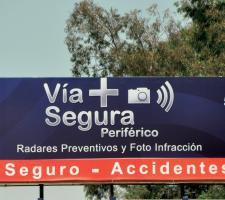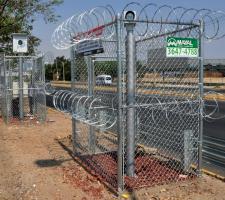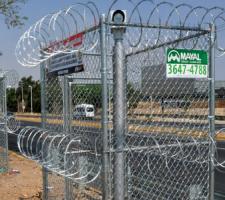
Fixed and mobile MultaRadar units automatically detect which lane a speeding car is travelling in – preventing failures due to images showing more than one vehicle.
A programme of road safety education and enforcement in the State of Jalisco in Mexico has reduced speed related fatalities by 40% in nine months
Speed enforcement equipment will appear in greater number and visibility around the city of Guadalajara over coming months, as the Mexican State of Jalisco expands its road safety campaign. This comes hot on the heels of an initial programme of traffic speed education and enforcement in Guadalajara, which has yielded remarkable results, reducing speed related fatalities by 40% during its first nine months of operation.Road safety practitioners will be aware that insufficient time has passed to allow credible evaluation that stands up to scientific scrutiny. Officials in Jalisco may experience some ‘regression to the mean’ when analysing the statistical results of their enforcement programme over coming years.
Nonetheless, it is very likely that casualty figures will continue downwards where speed enforcement equipment is deployed in and around Guadalajara.
There is also a distinct possibility that safety improves on roads in the city and state where equipment is not in place. Jalisco’s strategy is underpinned by a concerted educational campaign employing substantial media resources to spread key road safety messages applying to all of the state’s roads.
This is not to say that all is rosy for motorists on Jalisco’s roads. The state’s speed enforcement programme was instigated to combat a very big problem. During a single year at least 250 road deaths were recorded on Guadalajara’s El Periferico orbital highway, prompting the state to sign up to the UN Decade of Action on Road Safety and to draw up its own six point action plan. This would target speeding, wearing of seat belts, alcohol, motorcycle helmets, fitting of child seats and pedestrian safety as priority issues to be addressed.
“For tackling excessive speeding, Mexico’s national university in Unam carried out an analysis exercise to plot the locations of accident blackspots with the highest casualty rates across the state,” says Jalisco State Minister for transport and traffic Diego Monraz. “The study determined that of the 10 points with highest recorded numbers of fatalities, eight were situated on the El Periferico highway. The statistical analysis also showed that of the 250 victims per year, the main cause was high speed.”
A two-pronged attack
Jalisco’s Traffic Safety Agency (TSA) established the state’s strategy for reducing traffic speed, with the support of the“Initial work focused on amalgamating and improving all traffic signalling on Guadalajara’s orbital highway. We also set new more appropriate speed limits where the road design and conditions necessitated and we established our own special traffic sign for speed enforcement,” Monraz says. “Secondly, we established a financial strategy for the project. Government funding is not commonly available for financing such infrastructure, so we had to devise our own strategy to make it work. With this knowledge we designed a project and its specifications with the aim of it becoming self financing within two years. This was the only way to make the project feasible.”
For design and delivery of the scheme, TSA assembled a team consisting of Mexican traffic control systems company Autotraffic and the international enforcement specialist
The technological side of Jalisco’s enforcement programme would consist of eight radar speed monitoring units to be used in rotation around 16 strategically located and fixed installation sites. Furthermore, five mobile speed enforcement systems would be operated on the El Periferico by Autotraffic personnel for TSA. “Both fixed and mobile units are from our MultaRadar series, based on non-invasive doppler radar technology,” says Jenoptik area sales manager Miguel Valdivia. “The equipment automatically detects which lane the speeding car is travelling in and indicates this on the script line. This gives more evidence to the image evaluator and so greater certainty over which car was the offender, even when more than one car is shown on the image. Systems without this feature typically discard up to 20% of images due to uncertainty over which car pictured has committed the offence.”
Education campaign
Autotraffic would provide back office services for TSA – serving citations and processing these with the state authorities. But before that, prior to the system being launched and going live with enforcement in March 2011, a comprehensive social education campaign was put into action. This would include signs erected over the El Periferico. “The messages were used to communicate the dangers of speeding and to advertise or inform the public of the enforcement project,” Monraz says. The same messages were put out through television, radio, internet and magazine advertisements. “The educational campaign was an essential part of the overall project. Gaining public acceptance was one of the main aims, along with saving lives and making the project self financing so it could be sustainable after 24 months,” he adds.Over the first two months of the enforcement project after the MultaRadar sites and back office functions were activated for the first time, speeding offenders were sent ‘preventative’ citations. These displayed the image and speed captured by the equipment, but also informed recipients that the offences were not being enforced for that limited period of time. Offenders also received a copy of TSA’s speeding and road safety leaflet as part of the overall effort to get motorists used to the idea of the project. Monraz says: “This helped to reinforce the message that the main objectives are to save lives rather than to focus on raising money. To begin with, the people of Jalisco were generally quite fearful of the enforcement programme. But acceptance has grown as awareness of the project has spread and particularly since we were able to release the first statistical results from the project.”
Reach extending – safety improving
A total of 497,529 enforcement notices were issued during the first 12 months of the programme up to March this year, including the 50,000 non-enforced educational citations delivered during the first two months. The exact figure for the reduction in speed related fatalities during the first nine months is 38.89%, in comparison to the same period in 2010. Also significant is the apparent decrease in drivers’ speeds on the El Periferico. According to TSA’s reports, the numbers of speeding offences recorded have gone down by between 30% and 50% at the 16 fixed enforcement sites.Jalisco’s TSA is extending its enforcement programme to more roads in the state. According to Monraz, use of the mobile MultaRadar units has already spread to five more principal roads in Guadalajara. Seven Autotraffic enforcement teams will be using them on more roads within the city this year and additional equipment is due to be installed for red light as well as speed enforcement.
“Mexico’s agency for prevention of accidents has requested the specific details and specification of this project, so it can be used to demonstrate best practice in road safety,” Monraz says. “Road traffic accidents are the second highest cause of death in Mexico. The Jalisco government is convinced that such problems have to be addressed with solutions based on technology and scientific study and analysis, with society involved.
“A multi-sectoral approach, including the public, is important, as is determination of a financial structure to fund the project. The state of Jalisco had the necessary authority and capability to operate the enforcement programme itself, but contracting a service provider held two advantages: it prevented misuse of the equipment for uses other than enforcement; and it made possible more efficient use of the administration’s human resources.”














